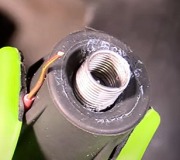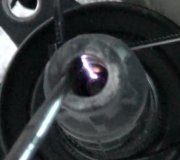I don't understand why you keep referring to voltages coming from the cam and crank sensors. Those are signal voltages we can't measure. We have to let the Engine Computer tell us when there's a problem with them. You found 12 volts at an injector for the first one second after turning on the ignition switch. That single observation proves the ASD relay and its circuitry is working, and the computer has control of it. The second, and more important part of the test is whether that voltage comes back during cranking. It's going to be lower because battery voltage is being drawn down by the starter. The industry-standard is it must stay above 9.6 volts during cranking, but it's more common to find it's around 10.5 to 11.5 volts if the battery is good and fully-charged. The exact voltage is not important. What IS important is that it's there. In fact, since digital meters take too long to respond, I always recommend using a test light for this test. There's no way the exact voltage reading can become a confusing variable. With the test light, the voltage is there during cranking, or it isn't.
Since you have voltage at an injector during cranking, we know the crankshaft position sensor and the camshaft position sensor have to be working. We know that because the correct response from the Engine Computer is it turns the ASD relay on. That relay sends current to the alternator field, the oxygen sensor heaters, the injectors, and the ignition coil. All of this part of the system is responsible for about 95 percent of crank / no-start problems, but we just proved this part is okay. That leaves the other 5 percent of causes. Roughly three percent of the additional crank / no-starts are caused by fuel pump failures, and the last two percent by ignition system failures.
Where some confusion is added to this story is the camshaft position sensor is part of the input signal system that feeds the computer, then the computer feeds the ignition output system and the injector output system. Both the input system, (cam sensor) and the output system, (ignition coil) are inside the distributor. By looking at the 12 volts feeding the ignition coil, we have proven the input half is working, but if you don't have spark, it's the output half that is not working. Since there is also an electronic module built into the distributor that runs the ignition coil, that is the logical place to find the cause of the no-spark, meaning a defective new distributor.
Another way to look at this is when the computer sees the signal pulses from the cam and crank sensors, it turns on three circuits. One is the ASD relay which feeds 12 volts to the ignition coil, injectors, and other places. Basically, it turns on power for the entire engine. The second circuit is the group of wires that pulse the grounds to the individual injectors to open them and allow gas to spray into the engine. The third circuit is the ground for the ignition coil that is pulsed on and off. We need the 12 volt feed to the coil and injectors. We're getting that. Now we need the pulsing ground circuits for the injectors and ignition coil. We don't know if we're getting those, however, those outputs are also monitored by the computer and it will set a diagnostic fault code if a problem is detected. These two circuits cause very little trouble.
Inside the Engine Computer, the driver circuit for the ignition coil is going to cause even less trouble than normal, because instead of driving the ignition coil, which requires a lot of power, it is simply providing the tiny triggering pulse that tells the module inside the distributor when to fire the ignition coil. High-power circuits need high-power transistors, and that always translates into much lower reliability. A power transistor will fail thousands of times more often than a little signal transistor. What was done here is the circuit with the highest chance of failure was moved out of the expensive Engine Computer and put into the less-expensive distributor.
A "noid" light can be connected to one of the injector plugs to see if it is being pulsed by the computer during cranking. If it pulses, it proves the ASD relay is turning on and the computer is running that injector, both of which proves the cam and crank sensors are working. At that point, the no-start has to be caused by no spark OR no fuel pressure, but not both. If you hear the hum of the fuel pump for the first second when you turn on the ignition switch, we know that's working, and the cause has to be no spark. I've never tried this with a regular test light but it should be able to give you some indication as to whether the injectors are being pulsed. You found the wire that is the same color at every injector. That's the one that gets 12 volts from the ASD relay. Move the test light to the other wire, then see what happens during cranking. (This has to be done by back-probing the wire through the connector while that connector is plugged into the injector). I suspect you should see a bright light for one second, then it should be dimmer during cranking. Because the filament glows for a while, I don't think you will see it pulsing, but either dim or pulsing indicates the computer is running the injectors.
You had asked originally about adjusting ignition timing with the distributor. You don't have to worry about that. It's the pulses from the crankshaft position sensor that are very precise and are used for spark timing. Those pulses are very far advanced, in the order of 30 - 40 degrees. Based on engine speed, load, coolant temperature, rate of throttle change, and many other factors, the computer calculates the amount of delay it wants after a crank sensor pulse is received, then it triggers the ignition coil. That's how it achieves the desired amount of spark advance. The camshaft position sensor's signal only tells the computer when a certain cylinder is coming up on top dead center. Even if that were to be wrong, you still have the rotor in the distributor to send the spark voltage to the right spark plug. Even if the wires were mixed up, at worst, as long as the computer is triggering the ignition coil, you'd have spark, but at the wrong spark plugs at the wrong time.
You can test the operation of the ignition coil with Chrysler's DRB2 and DRB3 scanners, and I'm pretty sure you can do that with your MT2500 too. Under "actuator test mode", (ATM), you can select individual injectors or the ignition coil and command the Engine Computer to fire them. It will pulse the selected circuit about once per second. You'll have to listen next to the distributor for the clicking, indicating the ignition coil is firing. You can also remove the distributor cap, then lay a small jumper wire near the coil terminal, THEN continue the coil test while watching for spark. It's a good idea to stop the test while you're removing the cap because the spark voltage may insist on finding a path to ground before you get the jumper wire in place. Depending where that spark jumps to ground, it may leave a carbon track behind. Carbon conducts electrical current, and if that path is easier to follow, spark current will follow that short rather than go down the spark plug wires.
As long as I'm piling on a lot of information, I should mention too how the spark plug wires can be mixed up. This applies to the older Mitsubishi 3.0L too that was used on Caravans and some cars. You must go by the cylinder numbers molded on the top of the cap right next to each plug wire. The terminal the spark is coming out of does not correspond to where the tip of the rotor is under the cap. If you simply start with plug wire number one, then go around the cap in the firing order, four spark plug wires will be in the wrong places. Your symptom will be quite different than the crank / no-start you have now. You would have popping and backfiring which would verify you have spark, but at the wrong time.
Tuesday, January 23rd, 2018 AT 1:09 PM



